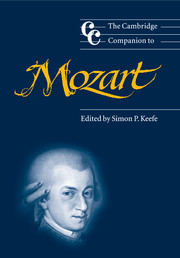13 - Mozart in the nineteenth century
from Part III - Reception
Published online by Cambridge University Press: 28 September 2011
Summary
. . . if ever Mozart became wholly comprehensible to me, he would then become fully incomprehensible to me.
søren kierkegaard, either/or (1843)Implicit in one of the more commonly held beliefs about our understanding of artworks and their creators is an oddly skewed relationship between proximity and distance. According to this view, early critics find themselves in the position of a spectator who, standing just a few inches away from one of Monet's paintings of Rouen cathedral, sees only daubs of paint and vague shapes. Just as the outline of the cathedral emerges only when the viewer takes a few steps back, so the image of the artist and his works is supposed to gain in clarity the farther we withdraw from it in time. This theory of reception has been applied most consistently to figures whose works were first deemed to be particularly challenging and thereafter enjoyed a more or less continuous afterlife. Mozart was such a figure. Recognized by his contemporaries as a prodigious though intractable talent, venerated as a ‘classic’ by later generations, he continued to pose interpretive challenges even for the most perceptive musicians of the mid-and late nineteenth century. ‘We are beginning to understand Mozart’, Berlioz wrote in 1862, and, indeed, we are still coming to terms with Mozart today. With increased understanding, however, comes loss – of the sense for precisely those idiosyncrasies that made Mozart's music such a challenge for early audiences. The study of Mozart reception in the nineteenth century is tantamount to a search for lost images, an activity that may ultimately lead us to reconsider our own assumptions about the composer and his works.
- Type
- Chapter
- Information
- The Cambridge Companion to Mozart , pp. 169 - 184Publisher: Cambridge University PressPrint publication year: 2003



